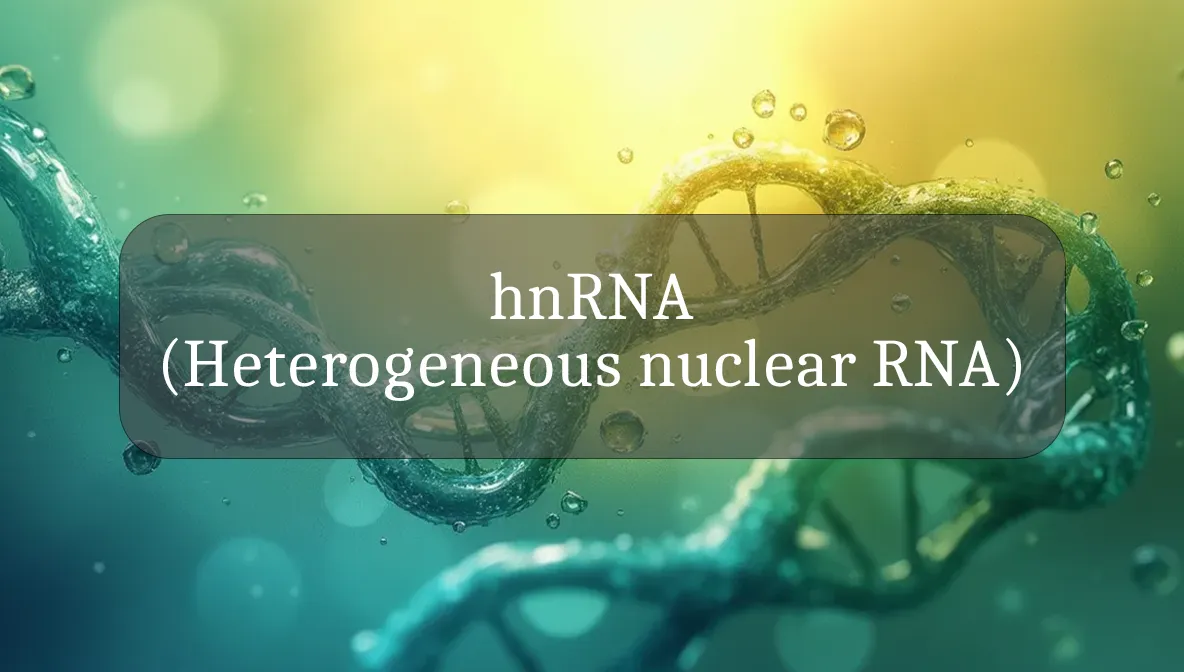Raw Blueprint of Gene Expression
Heterogeneous nuclear RNA (hnRNA) is like the rough draft of your genetic instructions, a diverse group of RNA molecules that serve as precursors to mature messenger RNA (mRNA). Found in the nucleus of eukaryotic cells, hnRNA is a key player in gene expression and a focus for health-conscious folks interested in cellular health and disease prevention. Understanding hnRNA can empower you to support your body’s genetic processes. Let’s explore what hnRNA is, why it matters, and how you can nurture its function for daily vitality!
Chemical Identity and Type
hnRNA refers to a heterogeneous group of single-stranded RNA molecules transcribed from DNA in the nucleus by RNA polymerase II. Ranging from 200 to over 100,000 nucleotides, hnRNA includes pre-mRNA, which contains both exons (coding regions) and introns (non-coding regions). It’s processed in the nucleus through 5’ capping, 3’ polyadenylation, and splicing to produce mature mRNA. Found in all nucleated cells, especially active in rapidly dividing tissues like the liver or immune cells, hnRNA is the raw material for protein synthesis. Think of it as a sculptor’s clay, shaped into precise mRNA for cellular functions.
Biological Role and Benefits
hnRNA is a critical intermediate in gene expression, offering these benefits when properly processed:
- Protein Synthesis: As pre-mRNA, hnRNA is processed into mRNA, which directs the production of proteins essential for growth, repair, and metabolism (e.g., enzymes, hormones).
- Gene Regulation: Alternative splicing of hnRNA allows one gene to produce multiple proteins, enhancing cellular adaptability (e.g., 80% of human genes undergo alternative splicing).
- Cellular Homeostasis: Accurate hnRNA processing ensures proper protein levels, supporting functions like DNA repair, immune response, and energy production.
- Tissue Specialization: Differential hnRNA splicing tailors protein expression to specific tissues (e.g., brain vs. muscle), maintaining organ function.
- Disease Prevention: Proper hnRNA processing prevents aberrant proteins that could lead to diseases like cancer or neurodegeneration.
Efficient hnRNA processing supports robust cellular function, promoting overall vitality.
Dietary or Natural Sources
hnRNA is produced endogenously during transcription, not consumed directly. However, diet and lifestyle can support its synthesis and processing:
- Folate-Rich Foods: Spinach, lentils, and asparagus (400–600 µg/day folate) support RNA synthesis by providing methyl groups for nucleotide production.
- Vitamin B6-Rich Foods: Bananas, chickpeas, and salmon (1.3–2 mg/day) aid RNA-processing enzymes (e.g., splicing factors).
- Zinc-Rich Foods: Oysters, pumpkin seeds, and beef (8–11 mg/day) stabilize RNA-binding proteins, enhancing hnRNA splicing accuracy.
- Antioxidant-Rich Foods: Berries, nuts, and green tea (rich in vitamins C, E) reduce oxidative stress, protecting nuclear RNA from damage.
- Omega-3 Fatty Acids: Fatty fish or walnuts (1–2 g/day) support nuclear membrane health, facilitating hnRNA processing.
A nutrient-dense diet creates an optimal environment for hnRNA production and processing.
Signs of Imbalance or Dysfunction
hnRNA dysregulation, often due to genetic mutations, stress, or nutrient deficiencies, may manifest as:
- Cancer: Mis-spliced hnRNA produces aberrant proteins, driving tumor growth (e.g., BRCA1 mis-splicing in 10–20% of breast cancers).
- Neurological Disorders: Faulty hnRNA processing is linked to Alzheimer’s (tau mis-splicing) or amyotrophic lateral sclerosis (TDP-43 mutations, affecting 5% of ALS cases).
- Developmental Issues: Splicing errors cause congenital disorders like spinal muscular atrophy (1 in 10,000 births) from SMN1 gene defects.
- Immune Dysfunction: Aberrant hnRNA splicing impairs immune protein production, increasing infection risk or autoimmunity (e.g., lupus).
- Fatigue or Poor Repair: Reduced protein synthesis from hnRNA errors may lead to slow healing or low energy, though non-specific.
These symptoms require medical evaluation, as hnRNA dysfunction is not directly testable outside research labs.
Supporting Optimal Levels or Function
To promote healthy hnRNA processing, try these evidence-based tips:
- Eat a Balanced Diet: Include folate-rich greens, B6-rich salmon, and zinc-rich seeds to support RNA synthesis and splicing.
- Reduce Oxidative Stress: Consume antioxidant-rich foods (berries, spinach) to protect nuclear RNA from damage by reactive oxygen species.
- Exercise Moderately: Walking or yoga (30 min/day, 5 days/week) enhances cellular metabolism, supporting transcription and RNA processing.
- Manage Stress: Chronic stress disrupts splicing; practice meditation or deep breathing (5–10 min/day) to lower cortisol, aiding nuclear function.
- Avoid Toxins: Limit exposure to pollutants (e.g., cigarette smoke, heavy metals) that impair RNA processing; choose organic produce and filtered water when possible.
Small, consistent habits foster a cellular environment for efficient hnRNA processing.
Safety, Interactions, and Precautions
hnRNA is a natural cellular component, but its dysregulation has health implications:
- Genetic Mutations: Splicing factor mutations (e.g., SF3B1 in 10–15% of leukemias) disrupt hnRNA processing; genetic counseling may be needed for hereditary risks.
- Medications: Some chemotherapies (e.g., spliceosome inhibitors) target hnRNA splicing in cancer but may affect healthy cells; used only under medical supervision.
- Environmental Toxins: Heavy metals or pesticides can disrupt RNA processing; minimize exposure via clean food and water sources.
- Nutrient Deficiencies: Low folate or zinc impairs RNA synthesis, increasing error risks; ensure adequate intake through diet or supplements (with medical guidance).
- Emerging Therapies: Antisense oligonucleotides correct hnRNA splicing in diseases like Duchenne muscular dystrophy, but these are specialized treatments.
Consult a healthcare provider for symptoms related to cancer, neurological, or developmental issues, as hnRNA research is not yet clinically diagnostic.
Fun Fact
Did you know hnRNA is like a genomic choose-your-own-adventure book? Through alternative splicing, a single hnRNA molecule can yield thousands of protein variants, allowing your cells to adapt like master storytellers!
Citations
- National Institutes of Health (NIH): RNA Processing and Splicing.
- Scotti MM, Swanson MS. RNA mis-splicing in disease. Nat Rev Genet. 2016;17:19–32.
- Wahl MC, et al. The spliceosome: design principles of a dynamic RNP machine. Cell. 2009;136:701–18.
- Matera AG, Wang Z. A day in the life of the spliceosome. Nat Rev Mol Cell Biol. 2014;15:108–21.
- Cleveland Clinic: Nutrition and Cellular Health.

